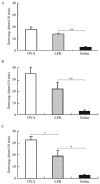Effects of lysed Enterococcus faecalis FK-23 on experimental allergic rhinitis in a murine model
- PMID: 23554753
- PMCID: PMC3596073
- DOI: 10.7555/JBR.26.20120023
Effects of lysed Enterococcus faecalis FK-23 on experimental allergic rhinitis in a murine model
Abstract
In the current study, we sought to investigate whether lysed Enterococcus faecalis FK-23 (LFK), a heat-killed probiotic preparation, attenuated eosinophil influx into the upper airway and had immunomodulatory activity in a murine allergic rhinitis model. Eighteen BALB/c mice were divided into three groups; the ovalbumin (OVA)-sensitized/challenged group, which received saline orally for 6 weeks (OVA group), the OVA-sensitized/challenged group, which received LFK orally for 6 weeks (LFK-fed group), and the non-sensitized group, which received saline for 6 weeks (saline control group). Nasal rubbing and sneezing were monitored during the study. After the final challenge, interleukin (IL)-4, interferon (IFN)-γ, and OVA-specific IgE levels in the sera and splenocyte culture supernatants were determined, eosinophilic infiltrate into the upper airway was quantified, and splenic CD4+CD25+ regulatory T cells (Tregs) were examined by flow cytometry. We found that nasal rubbing was significantly reduced in LFK-fed mice compared to the OVA group on d 27 and 35, and sneezing was significantly inhibited by LFK administration for 35 d. LFK-fed mice had significantly less eosinophil influx into the nasal mucosa than the OVA group. There were no significant differences between the LFK-fed group and OVA group in the serum and splenocyte culture supernatant levels of IL-4, IFN-γ, and OVA-specific IgE. Interestingly, the LFK-fed mice had a significantly greater percentage of splenic CD4+CD25+ Tregs than OVA group. Our results indicate that oral administration of LFK may alleviate nasal symptoms, reduce nasal eosinophilia, and increase the percentage of CD4+CD25+ Tregs in experimental allergic rhinitis.
Keywords: Enterococcus faecalis; allergic rhinitis; cytokines; eosinophils; mice; probiotics; regulatory T-lymphocytes.
Conflict of interest statement
The authors reported no conflict of interest.
Figures





Similar articles
-
[Anti-allergic effects of the probiotic preparations of enterococcus on experimental allergic rhinitis in mice].Zhonghua Er Bi Yan Hou Tou Jing Wai Ke Za Zhi. 2013 Jul;48(7):555-62. Zhonghua Er Bi Yan Hou Tou Jing Wai Ke Za Zhi. 2013. PMID: 24313204 Chinese.
-
Effects of lysed Enterococcus faecalis FK-23 on allergen-induced serum antibody responses and active cutaneous anaphylaxis in mice.Clin Exp Allergy. 2004 Nov;34(11):1784-8. doi: 10.1111/j.1365-2222.2004.02092.x. Clin Exp Allergy. 2004. PMID: 15544605
-
Effect of lysed Enterococcus faecalis FK-23 on allergen-induced immune responses and intestinal microflora in antibiotic-treated weaning mice.J Investig Allergol Clin Immunol. 2007;17(2):70-6. J Investig Allergol Clin Immunol. 2007. PMID: 17460944
-
Oral administration of Enterococcus faecalis FK-23 suppresses Th17 cell development and attenuates allergic airway responses in mice.Int J Mol Med. 2012 Aug;30(2):248-54. doi: 10.3892/ijmm.2012.1010. Epub 2012 May 24. Int J Mol Med. 2012. PMID: 22641478
-
Effect of lysed Enterococcus faecalis FK-23 (LFK) on allergen-induced peritoneal accumulation of eosinophils in mice.Clin Exp Allergy. 2003 May;33(5):684-7. doi: 10.1046/j.1365-2222.2003.01654.x. Clin Exp Allergy. 2003. PMID: 12752599
Cited by
-
Enterococcus faecalis FK-23 affects alveolar-capillary permeability to attenuate leukocyte influx in lung after influenza virus infection.Springerplus. 2013 Jun 20;2(1):269. doi: 10.1186/2193-1801-2-269. Print 2013 Dec. Springerplus. 2013. PMID: 23853748 Free PMC article.
-
Heat-treated and/or lysozyme-treated Enterococcus faecalis (FK-23) improves the progression of renal disease in a unilateral ischemia-reperfusion injury rat model.J Clin Biochem Nutr. 2024 Jul;75(1):78-89. doi: 10.3164/jcbn.24-29. Epub 2024 Apr 4. J Clin Biochem Nutr. 2024. PMID: 39070538 Free PMC article.
-
Viability Status-Dependent Effect of Bifidobacterium longum ssp. longum CCM 7952 on Prevention of Allergic Inflammation in Mouse Model.Front Immunol. 2021 Jul 20;12:707728. doi: 10.3389/fimmu.2021.707728. eCollection 2021. Front Immunol. 2021. PMID: 34354710 Free PMC article.
-
In vivo effectiveness and safety of probiotics on prophylaxis and treatment of oral candidiasis: a systematic review and meta-analysis.BMC Oral Health. 2019 Jul 10;19(1):140. doi: 10.1186/s12903-019-0841-2. BMC Oral Health. 2019. PMID: 31291932 Free PMC article.
-
Paraprobiotics: definition, manufacturing methods, and functionality.Food Sci Biotechnol. 2023 Jul 17;32(14):1981-1991. doi: 10.1007/s10068-023-01378-y. eCollection 2023 Dec. Food Sci Biotechnol. 2023. PMID: 37860741 Free PMC article. Review.
References
-
- Guarner F, Schaafsma GJ. Probiotics. Int J Food Microbiol. 1998;39:237–8. - PubMed
-
- Gionchetti P, Rizzello F, Helwig U, Venturi A, Lammers KM, Brigidi P, et al. Prophylaxis of pouchitis onset with probiotic therapy: a double-blind, placebo-controlled trial. Gastroenterology. 2003;124:1202–9. - PubMed
-
- O'Mahony L, McCarthy J, Kelly P, Hurley G, Luo F, Chen K, et al. Lactobacillus and Bifidobacterium in irritable bowel syndrome: symptom responses and relationship to cytokine profiles. Gastroenterology. 2005;128:541–51. - PubMed
-
- Shida K, Nanno M, Nagata S. Flexible cytokine production by macrophages and T cells in response to probiotic bacteria: a possible mechanism by which probiotics exert multifunctional immune regulatory activities. Gut Microbes. 2011;2:109–14. - PubMed
LinkOut - more resources
Full Text Sources
Research Materials

